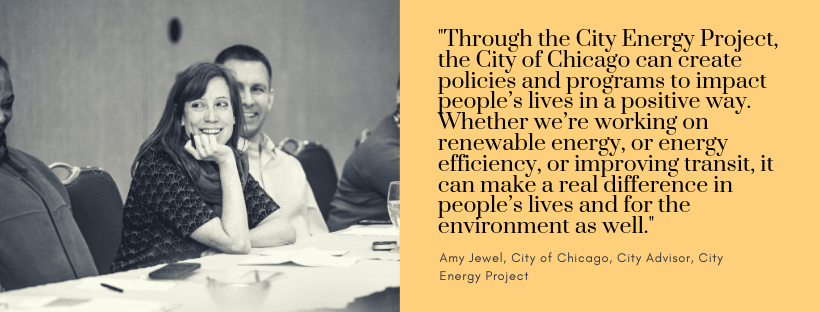What does it take to drive market transformation toward bigger, faster, deeper investments in energy efficiency? To figure this out, the City Energy Project, a national initiative from IMT and the Natural Resources Defense Council, embedded staff in 20 participating cities across the U.S. with a focus on boosting energy efficiency in buildings. These City Advisors help ensure that the energy efficiency efforts pursued by a city are customized to best meet local needs to maximize returns.
So what does transformative work look like in Chicago? Amy Jewel, the City Advisor in Chicago for 5+ years, gives us a peek.

What excites you most about the City Energy Project?
I’m excited by the fact that the work we do makes a big impact on the community. We spend so much of our lives in buildings, so any improvements we can make here are improvements that affect the quality of life and experiences of every Chicagoan. By implementing benchmarking and energy efficiency upgrades, we can save money, increase tenant comfort, and reduce pollution in our city.
What skills do you have that have helped you the most in your work?
Being able to communicate effectively with my colleagues and with stakeholders has been an asset. With stakeholders, it’s about more than explaining your ideas to them. It’s about listening and finding common ground on issues you both care about—working from your common interests in benefiting the community as a whole.
City Energy Project placed advisors in cities of varying size across the country. What was it like working in a large Midwestern city like Chicago?
As we share best practices and learn from other cities, we look at cities of all sizes. However, as the third- largest city in the U.S., we often look to other large cities such as New York and Los Angeles when we want to understand how other large cities are dealing with a particular issue. For example, New York and Chicago are both working on implementing building rating systems based on buildings’ ENERGY STAR scores. The other day, I was able to talk with my colleagues in New York about our approach, information sharing, and collaboration to implement and develop best practices.
What does your team look like?
I work closely with the Chief Sustainability Officer and the city’s Project Manager for Energy Policy and Engagement. We sometimes have additional Mayoral Fellows, AmeriCorps VISTAs, or interns supporting the work. We also work closely with multiple external partners on various aspects of the project like our Retrofit Chicago Energy Challenge. Through our partnerships with ComEd, Peoples Gas, the Joyce Foundation, the Chicago Regional Council of Carpenters, and others on this challenge, we have been able to help Chicagoans save $2.5 million to date.

What were some of the biggest challenges you faced while completing your work as a City Advisor?
Overall, larger cities like Chicago are moving pretty aggressively to lower their emissions and respond to climate change, but we all know when you look at the scale of the issue and the commitment required to solve it, our current actions are not nearly enough. What it boils down to is that cities need to do more to combat climate change, but sometimes it’s hard to match our action to the urgency of the problem.
What are some of the achievements you’ve made as a City Advisor?
I came on after Chicago’s benchmarking ordinance was passed, which was a big deal. I worked on the implementation of that ordinance and I’m proud of our success getting the word out, notifying covered buildings, and getting great compliance rates. Thanks to those results, we were able to leverage that success to create the new energy rating system that will be implemented this year. Basically, each building covered by the ordinance will be required to prominently display an energy score ranging from one to four stars that corresponds to their energy star score. Currently, we’re working on making PACE financing available for building owners in the Chicago area, which will help make energy efficiency improvements more accessible and affordable for Chicagoans. (Note: Learn more about Chicago’s efficiency efforts here.)
What advice do you have for other cities interested in becoming more sustainable?
Keep pushing for change and aggressive policies because that’s what we need. Also, look at sustainability holistically. Building energy efficiency is important and a great place to start, but it’s also related to clean energy, waste and recycling, transportation, and so many other things that touch people’s lives.
 The City Energy Project is a national initiative to create healthier, more prosperous American cities by improving the energy efficiency of buildings. The pioneering actions taken by the 20 participating cities are now distilled in a cured yet comprehensive City Energy Project Resource Library, a must-use tool for any jurisdiction on how to leverage energy efficiency to reach ambitious climate, economic, and social goals. Learn more at cityenergyproject.org.
The City Energy Project is a national initiative to create healthier, more prosperous American cities by improving the energy efficiency of buildings. The pioneering actions taken by the 20 participating cities are now distilled in a cured yet comprehensive City Energy Project Resource Library, a must-use tool for any jurisdiction on how to leverage energy efficiency to reach ambitious climate, economic, and social goals. Learn more at cityenergyproject.org.